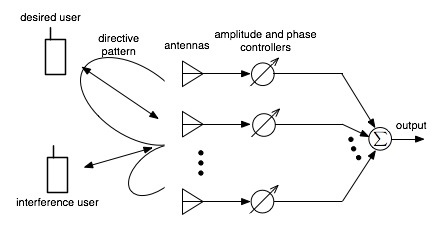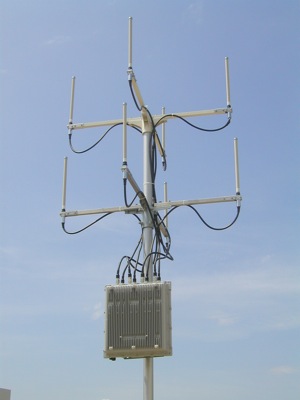スマートアンテナ
無線通信とは、その名の通りケーブル等を使わずに「空間」を媒体として、電波を用いて情報を伝送するシステムを指します。しかし、空間を媒体としているため他のユーザが存在する場合にはそれらからの信号が干渉となり、通信に影響を及ぼしてしまう可能性があります。また、様々な建物に電波が反射・散乱して伝搬路と呼ばれる電波の通り道が複数存在してしまい、その結果受信信号のレベルが大きくなったり、小さくなったりするフェージングが発生してしまいます。これらの問題を解決することが、無線通信を行うための重要な課題となります。
これらの問題を解決する技術の一つにスマートアンテナというものがあり、当研究室でもこのスマートアンテナに関する研究を行っています。そのスマートアンテナの基本的な概念図を下に示します。電波は波ですので、振幅と位相があります。同位相では強め合い、逆位相では弱め合うという性質があります。スマートアンテナはこの波の性質を利用して、希望ユーザからの信号を高いレベルで受信し、干渉ユーザからの信号を抑圧することができます。その方法を以下に簡単に説明します。下図に示したように、受信側では受信するアンテナを複数用意して、各アンテナで受信した信号の振幅と位相を制御した後に合成します。振幅と位相の制御を適切に行うことで、干渉ユーザの信号を抑圧し希望ユーザの信号を強めることが可能となります。このことを、指向性を制御すると言います。実際の通信では、希望ユーザと干渉ユーザがどこにいるか分からないため、様々な環境に追随して指向性を適応的に制御します。そのため、様々な環境において最適な受信をするアンテナということからスマート (賢い) アンテナと呼ばれています。また、環境に適応するという意味からアダプティブアンテナと呼ばれることもあります。通常、スマートアンテナの制御はディジタル信号処理技術を用いて実現されており、アンテナ工学と信号処理の境界に位置する研究領域と言えます。
Smart Antenna
A wireless communication is performed using radio waves without any cables, i.e., through "space" as its name means. Since it exploits the space as a medium, its communication quality may be degraded due to interference when other users exist. Also, multipath channels, which are caused by reflection of radio waves from various scattering objects, result in the phenomenon that received signal strength is enlarged or reduced, i.e., "fading." To address these issues is inevitable for wireless communications.
One of the techniques for alleviating the fading is a smart antenna. In our laboratory it has been studied for more than a decade. The following figure illustrates the concept of the smart antenna. Radio waves have their amplitudes and phases, of course. They have a property that identically phased rays add constructively and opposite phased rays add destructively. Exploiting the property, the smart antenna at the receiver enables us to obtain a desired stream with high signal level and to suppress other undesired streams. Its procedure is briefly explained next. As shown below, the receiver is equipped with multiple antennas which can independently adjust the amplitudes and phases of received signals. By controlling the amplitudes and phases optimally and combining the modified signals, we can suppress signals from interference users and selectively enlarge the desired signal. We call this process "to control directivity." In actual communications, the receiver cannot exactly find where the desired and interference users are. Hence it needs to adaptively control the directivity so as to track varying environments. This is the origin of the name "smart antenna" because it achieves optimum reception in a variety of situations. It is also called "adaptive (array) antenna" because it can adapt to the environment. In general, the implementation of core processes in smart antennas is achieved by using techniques in digital signal processing, so that it can be said that the research field of smart antenna is at the boundary of antenna techniques and signal processing.

スマートアンテナの概念図
Concept of a smart antenna.
下の写真は,スマートアンテナを実装したPHS基地局です。すでにこのような基地局が実際に運用されています。また、この基地局には当研究室との共同研究成果が一部用いられています。
The picture below shows a PHS base station equipped with a smart antenna, which is already operated in practical use. It contains part of the fruits of our collaborative research with a company.

スマートアンテナを搭載したPHS基地局
PHS base station equipped with a smart antenna.
[文献]
小川, 菊間, "アダプティブアンテナ理論の進展と今後の展望," 信学論B-II, vol. J75-B-II, no. 11, pp. 721-732, Nov. 1992.
Y. Ogawa and T. Ohgane, "Adaptive Antennas for Future Mobile Radio," IEICE Trans. Fundamentals, vol. E79-A, no. 7, pp. 961-967, 1996.
大鐘, 小川, "アダプティブアレーと移動通信 [I]-[IV]," 信学誌, vol. 81-82, Dec. 1998 - March 1999.
Y. Ogawa and T. Ohgane, "Advances in Adaptive Antenna Technologies in Japan," IEICE Trans. Commun., vol. E84-B, no. 7, pp. 1704-1712, July 2001.
[Reference]
Y. Ogawa and T. Ohgane, "Adaptive Antennas for Future Mobile Radio," IEICE Trans. Fundamentals, vol. E79-A, no. 7, pp. 961-967, 1996.
Y. Ogawa and T. Ohgane, "Advances in Adaptive Antenna Technologies in Japan," IEICE Trans. Commun., vol. E84-B, no. 7, pp. 1704-1712, July 2001.
